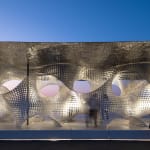









Yuandang Bridge / The Mainland
Further images
-
(View a larger image of thumbnail 1
)

-
(View a larger image of thumbnail 2
)

-
(View a larger image of thumbnail 3
)

-
(View a larger image of thumbnail 4
)

-
(View a larger image of thumbnail 5
)

-
(View a larger image of thumbnail 6
)

-
(View a larger image of thumbnail 7
)

-
(View a larger image of thumbnail 8
)

-
(View a larger image of thumbnail 9
)

-
(View a larger image of thumbnail 10
)

-
(View a larger image of thumbnail 11
)


Crossing Nature and Culture
Where Yuandang Lake meets Zhucaoyang in Eastern China, the Yuandang Bridge is a 600-metre-long, six-metre-wide, hybrid bridge for pedestrians and cyclists, connecting Jiangsu Province and the city of Shanghai. It snakes across the water, supported by Y-shaped steel columns, symbolising fluidity and aquatic life, and echoing the ripples on the lake.
A hybrid structure
The bridge is more than a transport link – it is a recreational facility with landscaping, seating, and space to play, and also a civic landmark that attracts visitors and boosts local pride. A study in how architecture and landscape design can open up new possibilities for regional infrastructure, the bridge is a floating garden connecting the lush vegetation on both banks. Pedestrians and cyclists can also enjoy shade from the trees in sunny summer days.
Play and leisure space
The bridge’s three wider sections serve as rest stops, a space to play and a viewpoint. Its most distinctive feature is a pavilion, a rain shelter near the middle of the bridge, where children can play. It is a mathematically modelled tunnel made of perforated metal sheets, whose undulating, porous, reflective walls present new perspectives. Visitors experience adventure and discovery as the tunnel’s appearance changes according to weather conditions, the season, and the time of the day. The tunnel allows visitors to immerse themselves in a kaleidoscope of light and shadow thanks to the perforations and reflective metallic surface.
A bridge to the past
Although the pavilion presents a sci-fi-like appearance, the architects’ inspiration came from the rocks of Lake Tai. The naturally formed holes in the limestone rocks were acknowledged by classical Chinese poets, artists, and scholars, and inspired great works of art. In this contemporary reinterpretation of Chinese heritage, the perforations and openings of the pavilion tunnel connect the present to the past, and visitors to their cultural heritage. As a nod to Chinese culture, the bridge’s curvature offers multiple perspectives and views as people cross the bridge, designed on the principle of a scholar’s garden. Drawing cultural references, the bridge prepares users for a journey that crisscrosses not only regional boundaries, but also temporal and cultural ones.
An ecological infrastructure
Extensive wetland parks are on both banks of the Yuandang Lake, and the bridge allows visitors to cross from one side to the other. There is a floating garden of local vegetation between the banks, and the bridge blends seamlessly with the surrounding natural beauty.

